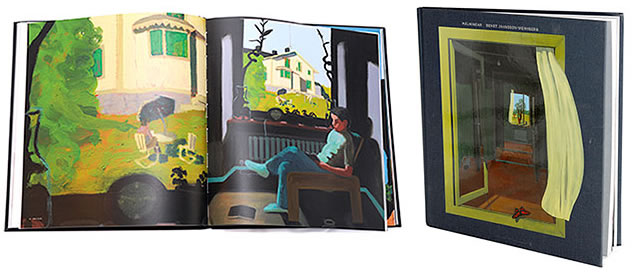
Once upon a time, on the sands of time…
People deeply absorbed by their reading is a recurring motif in Bengt Jahnsson-Wennberg’s paintings. With their gaze directed at the open book, and closed within themselves, something is happening that is concealed from the outside world. Seemingly unmoved, pictures and stories develop in the readers’ minds and despite their physical presence, they are somewhere else – that world made possible by the text, with no limits except those set by language and imagination. You can never know for sure, but these paintings seem to have an almost mirror-like relationship between the inner state and outer. You could also describe it as a frictionless transition from one to the other, since the inner and outer are actually one and the same. No matter how extraordinary things may appear within the frame, these occurrences are never strange or odd, but a natural part of the logic established by the painting. It could be a city park populated by monsters and exotic animals, which seem equally at home as the more ordinary inhabitants busy in their daily tasks. Or houses engulfed in flames, while people nearby methodically continue to load items into their car without noticing the unfolding catastrophe at all. One possibility is that what we see is partially invisible to the people in the picture, and this concerns a simultaneous, yet parallel course of events that the artist allows us to witness. With the aid of fiction, both the tangibly concrete and various levels of evasive reality are exposed, as if a curved room should happen to unfurl, only to just as quickly return to its closed self again.
The carefree movement between the many dimensions of existence, which characterises Bengt Jahnsson-Wennberg’s art, is also expressed in the spatial relationships of the pictures. At a definite level, there is often a hallway, a living-room or a kitchen with its character as specific as it is universal, and the same can be said of the people living there. Most often a man, either young or indeterminately middle aged, a woman, elderly persons and occasionally children. The interpretation is made with an elaborated sense of the room’s space and the volumes of the bodies. All peculiarities aside, the law of gravity applies here, drawing things inexorably to the ground. Even the air in the paintings has a striking palpability and clarity. Generally, the rooms have a window creating a relationship between the outside and inside. This relationship is never one and the same, but changes depending on the hours of the day. Days of bright sunshine make the view dazzle with intensity and the room dim. Then the remarkable happens: the outside world forces its way in and, paradoxically enough, appears just as close as the foreground interior. The buildings, trees and yard suddenly find themselves in the middle of the room. At dawn or dusk, equilibrium occurs between outside and inside and the eye moves seamlessly across the picture, but when night comes, it transforms into a mirror and the room is reflected in the black window. The effect is reminiscent of a doubly exposed transparency and makes it difficult to ascertain the real distance between things – quite simply, what is a reflection and what is not.
The movement between dream and reality is strongly connected to the multifarious nature of the room and both aspects contribute to the works’ imaginative storytelling. In the paintings and literary productions, Bengt Jahnsson-Wennberg tells stories where actual experiences provide a springboard for much greater journeys – often with the captivating fantasy of a fairy tale. Daily, repetitive routines barely disguise the other layers and, in actual fact, the recognisable façade leaks like a sieve. Individual pictures and series of paintings portray a course of events that turn conventional notions about the unity of time and space inside out. In an alarming – but also amusing – way, the world around us is destabilised and life’s most commonplace occurrences reveal a connection to undercurrents of desires and fancies, as unpredictable as they are absurd. Since the stories are created under these circumstances, the structure is often associative and open, which, to an unusually high degree, includes the viewer with his or her memories and experiences. In the midst of this dreamlike world however is an almost phenomenal attention to detail. Let your eye wander along the windowsill of Kolmården marble – a common feature in functional-style housing in the 30s – and every pot-plant is painstakingly observed and rendered, so you can see the difference between the leaves’ various tactile characteristics and which plants are in need of nourishment. Between the pots, there is dust and some miscellaneous items that have found their way there and stayed put. Objects consigned to oblivion by the blindness of perpetual vision. Letting the eye wander upwards, we see the roll-down curtain, its chord drawing a thin vertical line in the middle of the view. The curtain has faded and doesn’t roll up as it should. Likewise, it has been a long time since the venetian blinds were new and elastic. Now they hang sadly crooked. God is in the details, so it’s said, and portrayed here, with sensual presence, is the simultaneous ordinary nature and deep inscrutability of life itself.